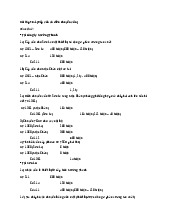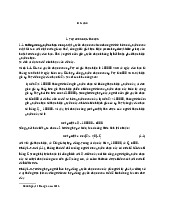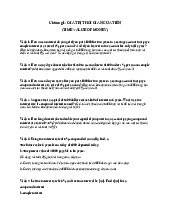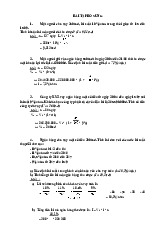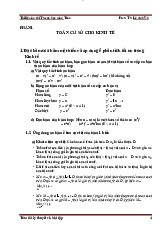



















Preview text:
lOMoAR cPSD| 47207194
2.8 Force Vector Directed along a Line
• In 3D problems, direction of a force F is specified by 2 points,
through which its line of action lies.
• F can be formulated as a Cartesian vector F = F u r F = F r lOMoAR cPSD| 47207194 F = F (x(x ) )
BB−−xxAA i)2+ −+ −(y(yBB yyAA )j2+ −+ −(z(z ) BB zzAA k)2 Application
Force F acting along the chain can be
presented as a Cartesian vector as follows.
• Establish x, y, z axes
• Form a position vector r along length of chain
• Determine the unit vector u= r/r that defines the direction of both the chain and the force lOMoAR cPSD| 47207194
• Finally, write F = F u Example 2.13 Given :
The man pulls on the cord with a force of 350N. Find :
Represent this force acting on the
support A as a Cartesian vector and determine its direction. lOMoAR cPSD| 47207194 Solution
• Coordinates : A (0m, 0m, 7.5m) B (3 m, – 2 m, 1.5 m)
• Position vector from A to B:
r = (xB – xA)i + (yB – yA)j + (zB – zA)k
= (3m – 0m)i + (– 2m – 0m)j + (1.5m – 7.5m)k
= {3i – 2j – 6k } m • Length of cord AB: lOMoAR cPSD| 47207194
r = ( )3 2 + − + −( 2)2( 6)2 = 7 m
• Unit vector in the direction of r.
r 3 2 6i − j− k 3 2 6 u = = = − − i j k r 7 7 7 7
• Force F has a magnitude of 350N & a direction specified by u. F = F u lOMoAR cPSD| 47207194
= (350 N ) 3 i − 2 j − 6 k 7 7 7
= {150i – 100j – 300k} N
• The components of the unit vector u give the coordinate direction angles. lOMoAR cPSD| 47207194 α= cos−1 3 = 64.6o 7 β=cos−1 −2 =107o 7 γ= cos−1 − 6 =149o 7 Example 2.14 Given :
The force FB = 750 N acts on the hook as shown. lOMoAR cPSD| 47207194 Find :
Express FB as a Cartesian vector. Solution • Coordinates : A (2 m, 0, 2 m) lOMoAR cPSD| 47207194 ( ) B − 54 5 sin30 m, o 54 5 cos30 ( ) ( ) m, o 53 5 m
B (– 2 m, 3.464 m, 3 m) • Position vector:
rB = (xB – xA)i + (yB – yA)j + (zB – zA)k
= (– 2 m – 2 m)i + (3.464 m – 0)j + (3 m – 2 m)k
= {– 4i + 3.464j + 1k } m
• Magnitude of rB rB = (−4)2 +(3.464)2 +( )1 2 = 5.385 m lOMoAR cPSD| 47207194
• Unit vector in the direction of FB rB − +4i 3.464j+1k uB= = rB 5.385
= –0.7428i + 0.6433j + 0.1857 k
• Force FB expressed as a Cartesian vector becomes
FB = FB uB
= (750 N) (–0.7428i + 0.6433j + 0.1857 k) lOMoAR cPSD| 47207194
= {–557i + 482j + 139k} N lOMoAR cPSD| 47207194 Example 2.15 Given :
• The roof is supported by cables as shown. • The cables exert forces
FAB = 100N and FAC = 120N on the wall hook at A. Find :
• Determine the resultant force acting at A.
• Express the resultant force as a Cartesian vector lOMoAR cPSD| 47207194 Solution
• Coordinates : A (0, 0, 4 m) B (4 m, 0, 0 ) C (4 m, 2 m, 0)
• Express FAB as a Cartesian vector rAB = (xB –
xA)i + (yB – yA)j + (zB –zA)k
= (4 m – 0)i + (0 – 0)j + (0 – 4 m)k
= {4i – 4k } m
rAB = ( )4 2 + −( 4)2 = 5.66 m
FAB =FAB AB u = FAB rrABAB lOMoAR cPSD| 47207194 =
100 N () 4i−4k ={707. i−707. k} N 5.66
• Express FAC as a Cartesian vector rAC = (xC – xA)i + (yC – yA)j + (zC – zA)k
= (4 m – 0)i + (2 m – 0)j + (0 – 4 m)k
= {4i + 2j – 4k } m lOMoAR cPSD| 47207194 2 2 2
r AC = ( 4) +( 2) +( −4 ) = 6 m r AC F = ACAC F u = AC AC F AC r ( 4 i +− 2 j 4 k = 120 ) N 6
= { 80 i + 40 j – 80 k } N • Resultant force
FR = FAB + FAC
= {70.7i – 70.7k } N + {80i + 40j– 80k } N lOMoAR cPSD| 47207194 R 2.9 Dot Product
• The dot product of vectors A and B is written as A·B (read A dot B). lOMoAR cPSD| 47207194
• It is defined as the products of the magnitudes of A and B and the angle between their tails.
A·B = AB cos θ where 0°≤ θ ≤ 180°.
• It is often referred to as the scalar product of vectors as the result is a scalar. Laws of Operation 1. Commutative law A B = B A lOMoAR cPSD| 47207194 2. Multiplication by a scalar
a (A B) = (aA) B = A (aB) 3. Distribution law
A (B + D) = (A B) + (A D)
Cartesian Vector Formulation
• Dot product of Cartesian unit vectors i · i = (1) (1) cos 0°= 1 i ·
j = (1) (1) cos 90 = 0 i · k = (1) (1) cos 90 = 0 • In summary, lOMoAR cPSD| 47207194 i · i = 1 j · j = 1 k · k = 1 i · j = 0
i · k = 0 j · k = 0
• If A = Ax i + Ay j +Az k and B = Bx i + By j + Bz k, then
A B = (Ax i + Ay j +Az k ) ( Bx i + By j + Bz k)
= Ax Bx (i i) + Ax By (i j) + Ax Bz (i k)
+ Ay Bx (j i) + Ay By (j j) + Ay Bz (j k)
+ Az Bx (k i) + Az By (k j) + AzBz (k k)
• Thus, to determine the dot product of two Cartesian vectors,
multiply their corresponding x, y, z components and sum these products algebraically. lOMoAR cPSD| 47207194
A · B = AxBx + AyBy + AzBz
Note: The result will be either a positive or negative scalar. Applications
(1) To determine the angle formed between two vectors or intersecting lines
• The angle θ between the tails of vectors A and B is given by θ= cos−1 A⋅B 0 ≤ θ ≤ 180 AB
